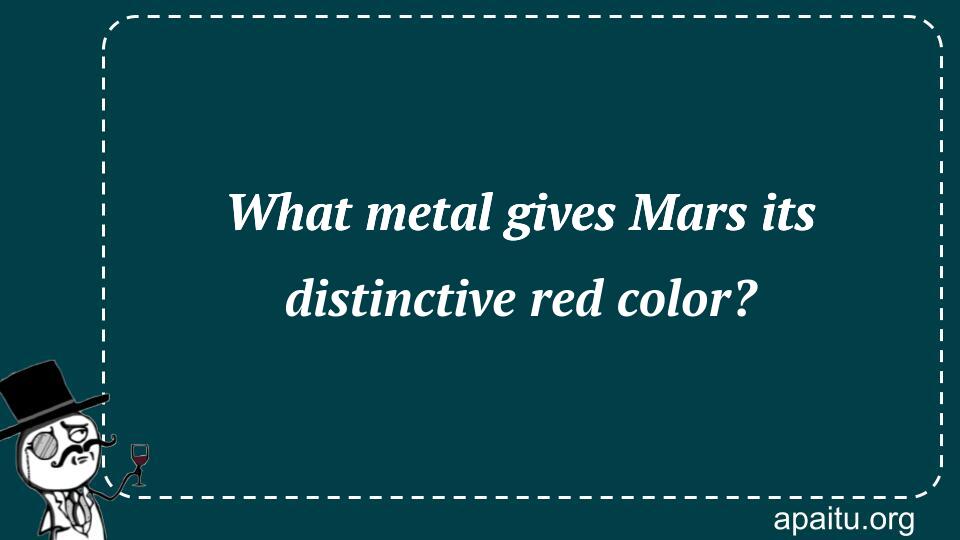Question
Here is the question : WHAT METAL GIVES MARS ITS DISTINCTIVE RED COLOR?
Option
Here is the option for the question :
- Iron
- Copper
- Aluminum
- Boron
The Answer:
And, the answer for the the question is :
Explanation:
Iron oxide, which is found in great concentrations on the surface of Mars, is the same substance that gives rust and blood their characteristic red colors. Massive red dust storms have a tendency to develop often throughout the surface of Mars. This is because Mars does not have significant amounts of water that can help to ground loose particles.

Greetings, space enthusiasts! Today, we embark on a cosmic journey to explore the captivating planet Mars and unravel the mystery behind its distinctive red color. Mars, often referred to as the “Red Planet,” boasts a captivating hue that has intrigued scientists and stargazers for centuries. The answer to this enigma lies in the presence of a remarkable metal known as iron. Join me as we delve into the science behind Mars’ crimson appearance and understand the role of iron in shaping the planet’s iconic color.
Iron, a common metal found abundantly on Earth, plays a crucial role in giving Mars its unique reddish hue. The Martian surface is covered in iron oxide, also known as rust, which imparts a distinctive reddish color to the planet. The iron oxide on Mars primarily consists of hematite, a mineral formed through the oxidation (or combination with oxygen) of iron.
But how did Mars acquire such a significant amount of iron oxide? The answer lies in the planet’s geological history. Mars is believed to have once had a much denser atmosphere and a warmer climate conducive to liquid water. Over time, as water interacted with the iron-rich rocks on the Martian surface, a process called oxidation occurred. This process led to the formation of iron oxide, coating the planet’s rocks, soil, and dust particles.
The iron oxide on Mars not only gives the planet its distinct red color but also has significant implications for its geology and climate. The presence of iron oxide indicates the past presence of liquid water, as the oxidation process requires the interaction of water with iron. This evidence has fueled scientific curiosity and the search for signs of ancient life on the Red Planet, as water is a crucial ingredient for the existence of life as we know it.
The iron oxide on Mars has also played a role in shaping the planet’s landscape. The reddish dust and soil blanket the surface, creating a distinctive Martian terrain. From towering mountains to vast plains, the iron-rich soil contributes to the diverse geological features that make Mars a fascinating subject of study for scientists and space explorers.
the iron oxide on Mars has practical implications for future human exploration and potential colonization. Iron is a valuable resource, and the abundance of iron oxide on the planet could provide a potential source for extracting iron and other useful metals. This possibility has sparked interest in the utilization of Martian resources for future space missions and the establishment of human settlements.
The study of Mars and its red color continues to be a subject of research and exploration. Scientists employ various tools, including orbiters, rovers, and landers, to study the planet’s geology, atmosphere, and the composition of its red surface. The data gathered through these missions not only enhance our understanding of Mars but also contribute to our knowledge of the solar system and the formation of rocky planets.
As we gaze at the night sky and observe the radiant glow of Mars, let us marvel at the role of iron in shaping the planet’s captivating red color. The iron oxide that blankets the Martian surface tells a story of geological processes, the presence of water, and the potential for further exploration. Mars, with its enigmatic red hue, remains a symbol of scientific curiosity and the human desire to unravel the mysteries of the cosmos.
iron is the metal responsible for giving Mars its distinctive red color. The presence of iron oxide, particularly hematite, creates a vibrant red hue that has fascinated astronomers and space enthusiasts for centuries. This iron oxide not only adds to the aesthetic allure of the Red Planet but also provides valuable insights into its geological history, potential for ancient life, and future exploration. As we peer into the cosmos, let us appreciate the role of iron in shaping the captivating beauty of Mars, our celestial neighbor.